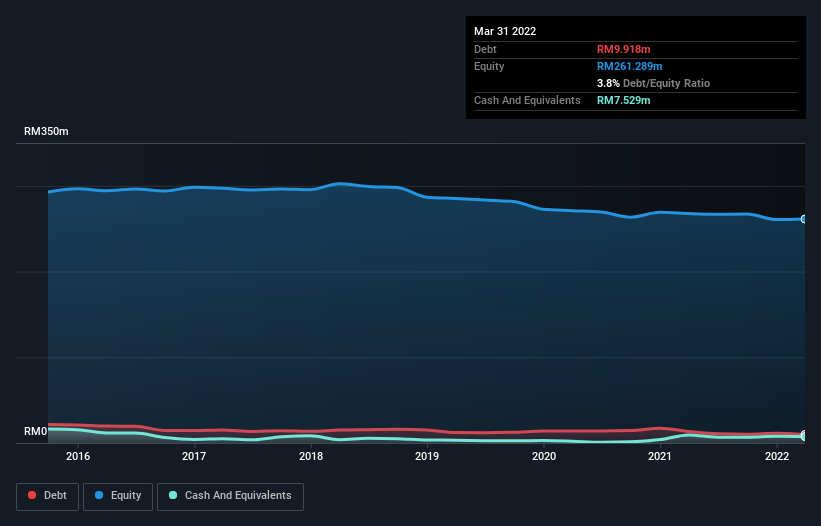We Think Astral Asia Berhad (KLSE:AASIA) Is Taking Some Risk With Its Debt

Howard Marks put it nicely when he said that, rather than worrying about share price volatility, 'The possibility of permanent loss is the risk I worry about... and every practical investor I know worries about.' So it might be obvious that you need to consider debt, when you think about how risky any given stock is, because too much debt can sink a company. Importantly, Astral Asia Berhad (KLSE:AASIA) does carry debt. But should shareholders be worried about its use of debt?
When Is Debt Dangerous?
Debt assists a business until the business has trouble paying it off, either with new capital or with free cash flow. If things get really bad, the lenders can take control of the business. However, a more common (but still painful) scenario is that it has to raise new equity capital at a low price, thus permanently diluting shareholders. Having said that, the most common situation is where a company manages its debt reasonably well - and to its own advantage. When we examine debt levels, we first consider both cash and debt levels, together.
See our latest analysis for Astral Asia Berhad
How Much Debt Does Astral Asia Berhad Carry?
The image below, which you can click on for greater detail, shows that Astral Asia Berhad had debt of RM9.92m at the end of March 2022, a reduction from RM13.4m over a year. However, it does have RM7.53m in cash offsetting this, leading to net debt of about RM2.39m.

How Strong Is Astral Asia Berhad's Balance Sheet?
According to the last reported balance sheet, Astral Asia Berhad had liabilities of RM7.42m due within 12 months, and liabilities of RM86.2m due beyond 12 months. Offsetting this, it had RM7.53m in cash and RM798.0k in receivables that were due within 12 months. So it has liabilities totalling RM85.3m more than its cash and near-term receivables, combined.
When you consider that this deficiency exceeds the company's RM69.3m market capitalization, you might well be inclined to review the balance sheet intently. Hypothetically, extremely heavy dilution would be required if the company were forced to pay down its liabilities by raising capital at the current share price.
We measure a company's debt load relative to its earnings power by looking at its net debt divided by its earnings before interest, tax, depreciation, and amortization (EBITDA) and by calculating how easily its earnings before interest and tax (EBIT) cover its interest expense (interest cover). Thus we consider debt relative to earnings both with and without depreciation and amortization expenses.
Given net debt is only 0.58 times EBITDA, it is initially surprising to see that Astral Asia Berhad's EBIT has low interest coverage of 2.1 times. So one way or the other, it's clear the debt levels are not trivial. Notably, Astral Asia Berhad made a loss at the EBIT level, last year, but improved that to positive EBIT of RM1.7m in the last twelve months. There's no doubt that we learn most about debt from the balance sheet. But it is Astral Asia Berhad's earnings that will influence how the balance sheet holds up in the future. So if you're keen to discover more about its earnings, it might be worth checking out this graph of its long term earnings trend.
Finally, while the tax-man may adore accounting profits, lenders only accept cold hard cash. So it's worth checking how much of the earnings before interest and tax (EBIT) is backed by free cash flow. Happily for any shareholders, Astral Asia Berhad actually produced more free cash flow than EBIT over the last year. That sort of strong cash conversion gets us as excited as the crowd when the beat drops at a Daft Punk concert.
Our View
Neither Astral Asia Berhad's ability to cover its interest expense with its EBIT nor its level of total liabilities gave us confidence in its ability to take on more debt. But its conversion of EBIT to free cash flow tells a very different story, and suggests some resilience. We think that Astral Asia Berhad's debt does make it a bit risky, after considering the aforementioned data points together. Not all risk is bad, as it can boost share price returns if it pays off, but this debt risk is worth keeping in mind. When analysing debt levels, the balance sheet is the obvious place to start. However, not all investment risk resides within the balance sheet - far from it. Be aware that Astral Asia Berhad is showing 3 warning signs in our investment analysis , and 1 of those doesn't sit too well with us...
If you're interested in investing in businesses that can grow profits without the burden of debt, then check out this free list of growing businesses that have net cash on the balance sheet.
New: Manage All Your Stock Portfolios in One Place
We've created the ultimate portfolio companion for stock investors, and it's free.
• Connect an unlimited number of Portfolios and see your total in one currency
• Be alerted to new Warning Signs or Risks via email or mobile
• Track the Fair Value of your stocks
Have feedback on this article? Concerned about the content? Get in touch with us directly. Alternatively, email editorial-team (at) simplywallst.com.
This article by Simply Wall St is general in nature. We provide commentary based on historical data and analyst forecasts only using an unbiased methodology and our articles are not intended to be financial advice. It does not constitute a recommendation to buy or sell any stock, and does not take account of your objectives, or your financial situation. We aim to bring you long-term focused analysis driven by fundamental data. Note that our analysis may not factor in the latest price-sensitive company announcements or qualitative material. Simply Wall St has no position in any stocks mentioned.
About KLSE:AASIA
Astral Asia Berhad
An investment holding company, engages in the cultivation of oil palm in Malaysia.
Mediocre balance sheet low.
Market Insights
Community Narratives


